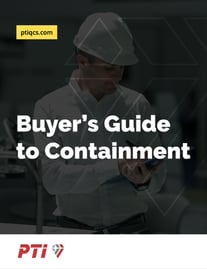When containment is needed, something has gone wrong, and mistakes cost money. Most see it as a cost center. An additional expense that should be avoided as much as possible.
But it doesn’t have to be that way. While many quality containment providers cater to this model of boom or bust - swooping in only when a quality issue calls for it, there is another option. The proactive containment model, which PTI QCS has long championed for our customers, offers a range of value-add benefits when properly implemented.

Proactive containment doesn’t just focus on Root Cause Corrective Action (RCCA). It helps identify areas for improvement, utilizes cutting edge technology to gather data and inform quality decisions that impact the entire organization, and helps develop a system that prevents further disruption. Let’s take a closer look at the difference between proactive and reactive containment and how the right combination of services can be beneficial for your organization.
The Problem with Reactive Containment
Reactive containment addresses any situation in which there is an acute quality issue that impacts the supply chain. When a faulty part is detected by an OEM or a Tier 1 manufacturer, an inspection plan is implemented as soon as possible to quarantine the impacted parts, removing them and any other affected materials before they reach assembly. At the same time, reactive containment helps implement a plan for maintaining the flow of parts needed to keep the assembly line operational at all levels and avoid or minimize downtime.
When hiring someone for an immediate quality issue, time is of the essence, so it’s important to evaluate:
- Service Levels - What is the reputation of the provider in terms of communication. Can you get them on the phone as soon as you need to speak with them? What level of reporting do they provide? How responsive are they via email, phone, messaging, or face-to-face? You need to know communication is a priority at all stages of the process.
- Process Management - SQA Engineers have limited time. They cannot spend all of it managing an inspection process. This can bottleneck the process and preclude them from other elements of their job. You want a containment provider who will guide you through every step with a reputation for excellence and experience that carries through every part of the project.
- Inspection Implementation - What do their core processes look like? How closely do those processes align with your own? Even if someone looks perfect on paper, if they have a rigid system that doesn’t’ sync with your own, it may not be a good fit.
Repositioning the Decision with Proactive Containment
Selecting the right containment provider can be highly stressful when a problem is already detected. You have hours, not days to select someone if there isn’t a company already in place (or if they are not able to scale to your needs immediately.
For this reason, many companies are now implementing a more proactive approach, vetting quality partners in advance of specific disruptions to address issues. There are many benefits to this, including:
- Support in Building a Plan - When you have a containment provider on your team in advance of specific disruptions, you can build a more robust plan that not only outlines how to react in the case of a quality issue; but that also keeps the company several steps ahead of potential quality issues, reducing the likelihood of it happening at all.
- Data Utilization - A proactive containment plan relies on technology to capture and utilize big data around plant operations, front line performance, and past quality issues. Instead of starting from scratch every time, you can build a plan that helps predict when a problem is likely to occur, learn from past inspection activities, and implement best practices from other companies that have faced similar issues.
- Bottom Line Savings - Proactive containment saves money. Not only does it reduce the risk of issues in the future; it helps to unlock hidden value in your organization, improving operations to avoid the risk of failures.

Whether you have a current quality containment provider or are looking for a proactive partner who can help reduce quality risks now and in the future, PTI can help. Download our Buyer’s Guide to Quality Containment to read the 11 questions you should be asking your provider and some of the technology and bottom-line considerations that will impact your company.



